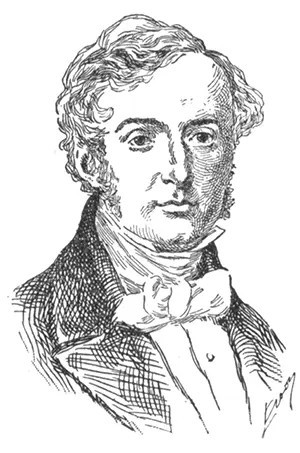August 1827: Robert Brown and Molecular Motion in a Pollen-filled Puddle

Among Albert Einstein’s seminal publications in his “miracle year” (annus mirabilis) of 1905 was a paper on the motion of small particles suspended in a stationary liquid. That work was rooted in the observations of a 19th century Scottish botanist named Robert Brown.
Brown was born in the coastal town of Montrose, north of Dundee, Scotland in 1773. The family moved to Edinburgh in 1790. Brown initially intended to study medicine at the University of Edinburgh, but soon fell in love with botany. He ventured into the Scottish Highlands, collecting plants and recording their descriptions in minute detail, and he discovered a new species of grass, Alopecurus alpinus.
His studies were interrupted by his military service, and he found himself stationed in Ireland as surgeon’s mate — a position that left him with plenty of time to pursue his botanical interests.
By the end of the century, Brown was well established as an amateur among the Irish community of botanists, even though he never completed a formal degree. But he had little hope of earning a living as a botanist, until he was selected to be the naturalist for a scientific expedition to explore “New Holland” — the continent we now know as Australia. His instructions were to collect as many plant, insect, and bird specimens as possible.
He set sail from London aboard the Investigator in July 1801 and stopped at the Cape of Good Hope several months later. Brown would later recall his two weeks there as “some of the pleasantest botanizing” he’d ever experienced. By December he had arrived in Western Australia, and he spent the next three and half years collecting 3400 specimens, some 2000 of them previously unknown species. Much of this collection was lost en route back to England, but there were still ample specimens for Brown to catalogue when he returned home in 1805.
This effectively launched his illustrious career in botany, although he was just as interested in studying the physiology of plants as collecting and classifying them. That is how he became fascinated with the pollen particles from the plant species Clarkia pulchella floating in water under his microscope — an instrument that was still a bit of a scientific novelty. Within those grains of pollen, he noticed even smaller particles jiggling in seemingly random motions, as if they were alive.
Brown was far from the first to report such motion in small particles. Around 60 BC, the Roman poet Lucretius noted the jiggling of dust particles suspended in air (which he claimed was proof of the existence of tiny indivisible air particles), but what he saw was more likely due to convection and turbulence. Nobody commented significantly on the phenomenon again until 1785, when Jan Ingenhousz discussed the strange motion of coal dust particles on the surface of alcohol.
Brown decided to repeat the experiment with many other kinds of plants, as well as powdered pit coal, glass, metals, and dust. He saw the same kind of jittery behavior, and concluded that the motion did not occur because the pollen particles were alive, since it also occurred in his dust samples. As he wrote at the time: “These motions were such as to satisfy me … that they arose neither from currents in the fluid, nor from its gradual evaporation, but belonged to the particle itself”.1
Today scientists understand the underlying mechanics of Brownian motion and appreciate its importance as a means of indirectly confirming the existence of atoms and molecules, and demonstrating how they move. But Brown died in 1858 without providing any kind of theory to explain what he had observed. That task fell to Einstein nearly 50 years later.
Einstein reasoned that if tiny but visible particles were suspended in a liquid, the atoms or molecules in that liquid would bombard the suspended particles and cause them to move randomly. He explained this motion in much greater detail in a 1908 paper. He showed that the mean square distance the particle travels is a linear function of time, with the rate depending on the temperature, the drag coefficient, and Boltzmann’s constant.
With accurate maps of a suspended particle’s successive displacements versus time, this prediction could be tested experimentally. A French physicist named Jean Baptiste Perrin did the experiments, and he concluded that his results "cannot leave any doubt of the rigorous exactitude of the formula proposed by Einstein.”
In 1991, a short comment in the Bulletin of the American Physical Society by D.H. Deutsch raised the question of whether the microscopes of Brown’s era had sufficient magnification to enable him to observe what he’d claimed2. A British microscopist named Brian J. Ford leapt to Brown’s defense, arguing that it was clear from Brown’s own writings that the botanist was studying particles in a closed environment, and that he understood how turbulence and convection might influence his observations3. Ford also memorably recreated Brown’s original demonstration and videotaped it. Most scientists now accept that Brown’s original observations of pollen grains were indeed the result of Brownian motion.
This article appeared in the August 2016 issue of APS News.
Brown, Robert. “A brief account of microscopical observations on the particles contained in the pollen of plants and the general existence of active molecules in organic and inorganic bodies.” Edinburgh New Philosophical Journal (1828): 358–371.
Deutsch, D.H. “Did Robert Brown Observe Brownian Motion: Probably Not.” Bulletin of the American Physical Society 36 (1991): 1374.
Ford, Brian J. “Confirming Robert Brown’s Observations of Brownian Movement,” Proceedings of the Royal Microscopical Society 31 (1996): 316–321.